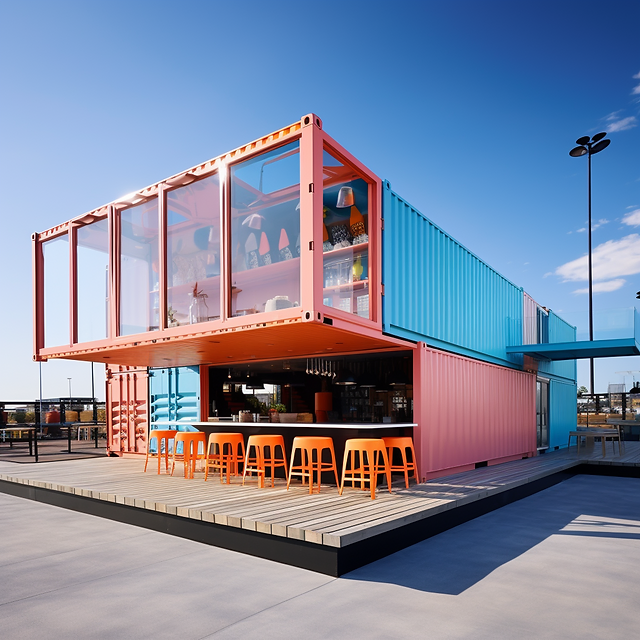Revolutionizing Space: The Rise of Innovative Shipping Container Modifications
What began as a movement within niche communities has burgeoned into a global phenomenon, transforming the approach to challenges regarding living, working, and engaging with our environments. In this deep dive, we’ll explore the fascinating world of shipping container modifications—their benefits, processes, challenges, and prospects.
Key Takeaways
- The significance of sustainability and practicality in shipping container modifications.
- An exploration of the multifaceted uses and global appeal of modified containers.
- Strategies for effectively navigating the technical and regulatory landscape of container modification.
Understanding the Basics of Shipping Container Modifications
In an age where adaptability and sustainability are more than buzzwords, there’s an increasing trend of using custom-built shipping containers to create dynamic, eco-friendly spaces. Let’s begin by unraveling the concept of shipping container modification. It’s about transforming the simple, sturdy boxes designed for transporting goods across oceans into vibrant and functional spaces. Think cozy homes, avant-garde offices, and chic cafes—each repurposed container has a story of innovation and resourcefulness. By recycling these containers, architects and designers are cutting down on construction waste and crafting bespoke spaces that are as versatile as they are robust.
The Process Behind Customizing a Container
Personalizing a shipping container is a process infused with creativity and guided by engineering. The initial steps involve meticulous design and planning. During this phase, the dreams of a quaint studio or a cutting-edge workshop first take shape on paper or, increasingly, within digital realms through innovative design software. It’s a stage where structural integrity intersects with aesthetic vision. As windows are carved out and heating systems introduced, the once cold and impersonal containers morph into inviting spaces tailored to specific needs. It does not only hinge on artistic vision but also on the precision of execution, where the strength of the container must remain uncompromised.
The Environmental Impact of Container Architecture
Modifying shipping containers for new uses carries profound environmental implications. In an age where sustainable practices are paramount, repurposing containers is an exemplary model for green construction. This type of architecture reduces the demand for new materials and minimizes the excess waste commonly associated with conventional construction. Further, efforts to improve insulation and incorporate energy-efficient systems enhance the eco-profile of these projects. The convergence of these eco-friendly trends within the container modification movement aligns seamlessly with the global push toward sustainable living. It underscores the appeal of these structures to environmentally conscious planners and dwellers alike.
Unique Uses of Modified Shipping Containers
Imagine stepping into a modern office space with high ceilings and glass facades, yet knowing it was once a humble shipping container. Such transformations are now commonplace as creative minds repurpose these metal boxes into more than storage units or temporary shelters. Their sturdiness and modularity have been capitalized upon to create luxury homes, bustling retail spaces, and modular classrooms, providing swift, customizable solutions to space constraints. Far-reaching and inventive uses of this nature underscore the growing recognition of containers as viable building blocks for many applications. The imaginative range of projects showcased around the globe attests that these containers are breaking stereotypes and redefining the essence of adaptive design.
Navigating Zoning Laws and Building Codes
Success in container modification comes from design and construction prowess and skillful maneuvering of the landscape of regulations and standards. Zoning laws and building codes can vary significantly across different jurisdictions, making them particularly daunting for the uninitiated. Compliance is crucial to ensure safety and functionality and avoid legal setbacks, which can turn a visionary project into a stalled endeavor. Thorough research and collaboration with experts in the legal and construction fields can aid in averting potential roadblocks and facilitate smoother project development.
Shipping Container Modifications Around the World
The utilitarian shipping container has undergone a global metamorphosis, emerging as a versatile actor in the theater of modern construction. This global embrace of container modification speaks to a universal appreciation for its inherent benefits—cost-effectiveness, durability, and scalability. From the United States to Japan, people are finding refuge, business opportunities, and creative spaces within these transformed steel casings. The global conversation around these projects highlights the cross-cultural appeal of container modifications and poses these humble structures as innovative solutions to global housing challenges and commercial space scarcities.
Cost Analysis – Is Modifying a Container Worth It?
Calculating the cost-effectiveness of shipping container modifications requires a holistic view. The allure of a potentially lower entry cost must be weighed against the entire lifecycle of the modified container. Insulation, heating and cooling systems, or architectural features can inflate the initial budget. Nevertheless, compared with traditional builds, the long-term benefits often tip the scales in favor of modification. The resilience of these steel structures implies longevity and reduced maintenance costs, presenting a potentially sound investment for those considering alternatives to conventional construction methods.
Overcoming Challenges in Container Modification
The journey of container modification has its challenges. Project initiators often grapple with insulation, climate control, and spatial restrictions. Added to that are potential logistical obstacles, like transporting the containers to their final destination or maneuvering them into tight urban spaces. A blend of ingenuity and technical expertise is invariably called upon to surmount such barriers. Professionals within the field continually push the boundaries, devising innovative solutions that enable these metal boxes to transform into comfortable, aesthetically pleasing, and functional spaces against all odds.
The Future of Modified Shipping Containers
The untapped potential in shipping container architecture suggests a thriving future. Upcoming waves of innovation hint at integrating smart home technology, renewable energy systems, and even robotics in the modification process. As environmental considerations become increasingly crucial, we may also see a rise in using biodegradable materials and green roofing on container buildings. These anticipated advancements bolster the claim that container modifications are not just a fleeting trend but a lasting solution in the evolution of adaptive and responsible architecture.
Getting Started with Your Container Modification Project
One must first secure a reliable container supplier and a proficient modification team to embark on a successful container modification project. Collaborating with experts who share your vision can be instrumental in turning your concept into a tangible reality. As the project unfolds, it’s essential to have a checklist covering all critical stages—from design to delivery—to ensure that nothing is overlooked. Furthermore, regular upkeep is not overly burdensome, thanks to the container’s inherent durability, making it all the more attractive as a long-term solution for various space needs.
Stay in touch to get more updates & news on Discover Tribune!





